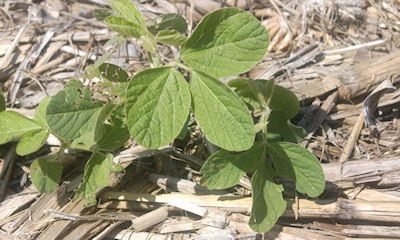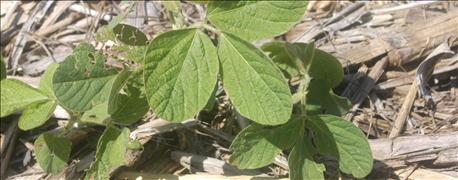June 17, 2015

Counting soybean plants just after plants are up and in the cotyledon or unifoliate growth stage is a good method to evaluate the crop stand, says Hans Kandel, North Dakota State University Extension agronomist.
Based on various hail loss studies and other research, the minimum stand for soybean in North Dakota is suggested to be around 75,000 plants per acre, which is approximately 50% of the recommended stand. If you use the "hula hoop" method to estimate the number of plants in solid seeded fields, you would need a minimum of 1.75 plants per square foot, he says.

A young plant pushes up through corn residue. Now is the time to do a stand count to make sure you have enough plants for a profitable yield.
The hoop should be tossed randomly at five different locations in the field and plants should be counted within the hoop. The area of a hoop can be calculated by the formula: Area = πr2, where r is the radius (or half the diameter of the hoop) and π (pi) is approximately 3.14.
So with a hoop diameter of 24 inches the area is 3.14x122 = 452 square inch / 144 = 3.14 square feet. If the average number of plants in this hoop is 6, the population estimate can be calculated to be 6/3.14 (area of the hoop in square feet) x 43,560 (square feet per acre) = 83,236 plants per acre.
When you use 30, 14, or 7 inch row spacing, you need at least on average 4.3, 2, and 1 plants per foot of row, respectively, to equal 75,000 plants per acre, Handel says.
"It is important to count several feet per row at various locations per field and average the numbers to estimate the stand. When you have a 50% reduced stand, yield reduction will be somewhere between 10-20% of the potential yield of a timely planted soybean field with 150,000 established plants," he says.
Soybean stands usually are not uniform throughout the field and there will be areas with higher or lower plant counts. With uneven emergence and gaps between plants, yields may be lower compared with an evenly distributed low stand of 75,000 plants per acre.
Soybeans have the ability to compensate for a low number of plants per acre by additional branching, more pod production per plant, more seeds per pod, and increased seed size, according to Handel.
The plants in low population environments may have branches lower on the stem that break before or during harvest thus increasing the potential for greater harvest losses. Also some of the pods will develop lower on the plant.
Source: NDSU Crop and Pest Report
You May Also Like




